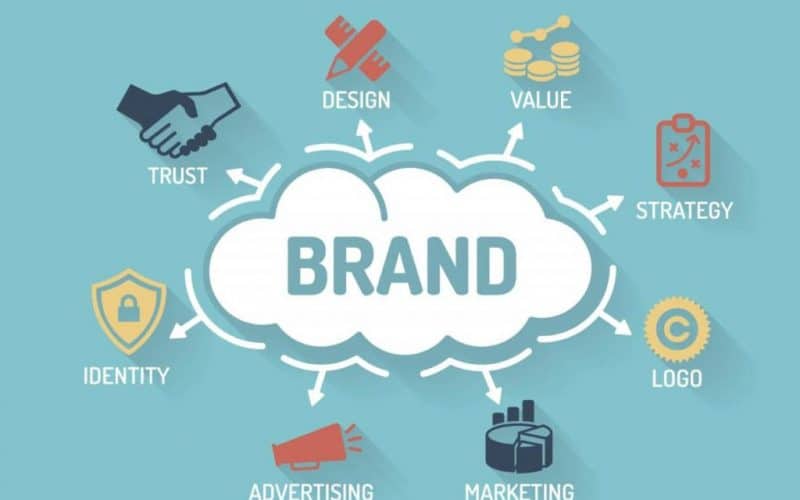When I initially started in branding, I realized the importance of creating a strong brand identity. However, getting the basics right from the start can be difficult. I recall the trial and error process I went through while attempting to piece together the elements that would eventually characterize my brand. In this essay, I’ll discuss the principles of brand identity, supported by statistics and insights that go beyond conventional recommendations. Let’s look at how you may create a captivating brand identity that connects with your audience and distinguishes you from the competition.
What is Brand Identity?
Brand identity refers to all of the visual and tactile elements that reflect your brand, such as your logo, colors, typography, and general design style. It’s how your brand looks, feels, and communicates with your target audience. Lucidpress found that consistent brand presentation across all platforms can improve income by up to 23%.
When I originally started establishing my brand, I underestimated the value of a consistent visual identity. Not until I invested in professional design and consistent branding did I notice a big improvement in customer awareness and trust.
Key Takeaways
- Brand identity refers to the visual elements of a brand, such as color, design, and logo, that help consumers recognize and distinguish the brand.
- Consistent marketing and messaging result in consistent brand identity and, consequently, consistent revenue.
- Building a positive brand image helps increase steady sales and make product launches more successful.
- To create a positive, unified brand image, analyze the firm and its market, as well as identify the organization’s goals, customers, and message.
- Social media is an effective driver of brand recognition.
Key Elements of Brand Identity

#1. Logo Design
Your brand’s identity is represented by its logo. It is frequently the first thing consumers notice and remember about your business. A well-designed logo should be simple, distinctive, and reflect your brand’s ideals.
According to Renderforest, 60% of people shun firms with unappealing logos, while 78% regard logos as works of art.
I remember working with a graphic designer to improve my logo. The transition from a simple design to a professional, polished logo had a significant impact on how potential clients saw my brand.
#2. Color Palette
Colors elicit emotions and can shape perceptions. Your color palette should be consistent with your brand’s personality and ideals. According to the University of Loyola, consistent use of color increases brand recognition by 80%.
Consider brands like Coca-Cola (red) and Facebook (blue). Their colors are readily recognizable and elicit specific emotions.
#3. Typography
Typography is an important part of your brand’s visual identity. The fonts you select should be legible and communicate the appropriate tone. Whether modern, traditional, playful, or serious, your typography should be consistent with your brand’s message.
According to an MIT study, changing fonts can elicit different emotions and influence user experience.
#4. Imagery and Graphics
The images and visuals you employ should be consistent with your brand’s style. High-quality, relevant pictures can greatly improve your brand’s attractiveness and storytelling.
I once updated the imagery on my website to better reflect my brand’s story. Engagement rates skyrocketed, and clients praised the professional and coherent appearance.
#5. Brand Voice
Your brand voice is the way you communicate with your target audience. It should be consistent across all platforms and convey your brand’s identity. Your brand voice, whether formal, pleasant, funny, or authoritative, should appeal to your target demographic.
Nike utilizes a motivating and encouraging tone, whereas Mailchimp uses a warm and approachable tone.
How to Develop a Brand Identity
- Research your audience, value proposition, and competitors.
- Create the logo and a template for it.
- Include language that you may use to connect, advertise, and embody on social media.
- Know what to avoid.
- Monitor your brand to ensure that it retains its identity.
Building a brand should not be done in haste. Numerous moving pieces go beyond creating a logo and selecting some crucial colors. Developing a brand identity will require the following:
Step #1. Research your audience, value proposition, and competitors
The first stage in creating a brand identity, like any other component of beginning a business, is to conduct market research. You should clarify and comprehend these five points.
Begin by identifying your target audience’s pain points and articulating how your company or product can help solve them.
1. Audience
It’s no secret that everyone wants something different. You can’t (generally) market a product to a pre-teen in the same manner you would to a college student.
Learning what your target audience expects from a company in your field is critical to creating a brand that people will adore.
2. Value Propositions and Competition
What distinguishes your business from others in your industry? What can you offer your customers that others cannot? Understanding the distinction between you and your competitors is critical to creating a successful brand.
Keeping an eye on your competition will teach you what branding methods work and which don’t.
3. Mission
You understand what your company delivers, but make sure you have a clear and concise mission statement that outlines your vision and ambitions.
In other words, understand your company’s mission – you can’t establish a personality for a firm until you know what it’s about.
Incorporate your goal and vision into all you do, and form meaningful relationships with people and organizations who share your beliefs.”
4. Personality
Even if you’re not branding an individual, you can still be personable when creating a brand image. Use typeface, colors, and imagery to convey the brand’s personality, and then augment that visual representation with your tone of voice.
Are you a confident business with a lot of sass, like Nike, or are you ritzy and professional, like Givenchy? Either way, you should design your brand to match your firm.
Research may be tedious, but the more you understand about your company, the stronger your brand identity will be.
5. SWOT Analysis
Finally, completing a SWOT Analysis will help you better understand your brand by identifying the attributes you wish to express.
SWOT refers to:
- Strengths: Positive aspects of your business that provide you an advantage over your competitors.
- Weaknesses are characteristics that prove to be detrimental to your business.
- Opportunities: Changes and trends in your industry that can benefit your firm.
- Threats are elements in the environment or industry that may cause problems for your company.
Step #2. Create a logo and template for it
Once you have a thorough understanding of your business, it’s time to bring your brand to life. Design serves as your brand’s silent ambassador. Here’s what you’ll need to know.
1. Logo
Although the logo is not full of brand identity, it is an important aspect of the branding process because it is the most identifiable part of your brand. It appears on your website, business cards, and online ads.
With your logo on all of these elements, your branding should look as seamless as this example:
2. Interesting form
As important as your logo is for branding, it is not the only factor that contributes to a great brand identity. Your product(s), packaging, and presentation of your services must all play a role in your brand identity.
Visually reflecting your brand in everything you do will help to develop consistency and familiarity with your customers.
Take McDonald’s golden arches as an example: they employed an unusual shape to create the iconic “M,” which is now recognized throughout the globe.
3. Color and Type
Creating a color palette is a way to boost your identity; it gives you flexibility, allowing you to develop new designs for your business while being true to the brand identity.
Although “mix and match” type design has become a popular trend, it doesn’t necessarily indicate that combining a few fonts is a good option for your business.
Typography should be used consistently throughout your logo, website, and any documents created by your company (print and digital).
Nike’s website and advertisements use the same typeface and type style throughout the firm, and it works beautifully.
4. Templates
You presumably send emails, type letters, or distribute business cards to potential consumers on a daily basis.
Creating templates (even something as small as email signatures) will offer your company a more uniform, respectable, and professional appearance and feel.
5. Consistency
As previously stated (and I cannot emphasize this enough), consistency is what may create or ruin a brand identity.
To develop a cohesive brand identity, use the aforementioned templates and stick to the design choices you’ve made for your brand across all aspects of your organization.
6. Flexibility
Yes, consistency is essential — but remaining adaptable in a society that is constantly looking for the next best thing is equally critical.
Flexibility allows for changes to ad campaigns, taglines, and even some modernization of your overall brand identity, ensuring that your audience remains engaged.
The idea is to keep any changes you make consistent throughout your entire brand (for example, do not change the design of your business cards without changing anything else).
7. Document
One of the most effective ways to ensure that a company follows its branding “rules” is to develop a set of brand guidelines that detail all of your brand’s do’s and don’ts.
Skype is one brand that has done a great job of creating a clear, consistent brand guide that everyone can follow. This is one approach to empower individuals to build brand assets and share your brand while staying brand compliant.
Step #3. Include language that you may use to connect, advertise, and embody on social media
Now that you’ve built your brand within your firm and completed all of the essential procedures to develop it, you’re ready to integrate it into your community.
One of the most effective methods to achieve this is for your brand to provide high-quality content.
1. Language
Use language that reflects your brand’s personality: if your brand identity is high-end, use professional language; if your brand is more casual, use conversational language.
The language you select to employ as a brand will be integrated across the entire firm, so make sure your tone matches your brand’s personality.
2. Connection and Emotion
People enjoy stories, particularly those that impact them emotionally and motivate them to take action.
A good brand identity can create an emotional connection with customers, laying the groundwork for a long-term relationship with the brand.
3. Advertise
Designing advertisements, whether traditional or digital, is the most effective approach to introducing your brand to the world. It is a way to get your brand’s message seen and heard by your target audience.
4. Social Media
Social media is another excellent approach to communicating with your customers, as there are numerous channels available on the internet that may help you develop your brand identity.
Coca-Cola makes excellent use of its Facebook cover photo real estate, keeping it consistent with the happiness theme.
Social media is extremely vital for communicating with customers and creating brand affinity.
If your brand is referenced in a tweet, status, or post (especially if the consumer has a query or a problem), make sure you respond quickly to your customers to maintain a positive reputation.
Step #4. Learn what to avoid
You can follow all of the stages to creating a strong brand identity, but if you engage in any of the following activities, your brand may falter or fail.
1. Do not send mixed messages to your customers
Know what you want to say, and use proper language and pictures to convey it. Just because something makes sense to you does not imply it will make sense to your consumers.
2. Do not copy your competitors
Your competitors may have excellent branding, and because you’re providing the same items or services, you may be tempted to duplicate what you know works – but don’t.
Take what they do and put your own spin on it to help your firm stand out in your sector even more.
3. Maintain consistency across online and offline
Yes, your print content may differ from your internet presence, but the colors, typography, theme, and message should all be consistent.
4. Scale, don’t sacrifice
As your brand expands into new channels, resist the temptation to simply chase trends that do not align with your brand’s DNA. Scaling identity requires iterating on the original music sheet, rather than creating a new song entirely.
Step #5. Keep an eye on your brand’s identity to ensure it remains consistent
It’s tough to tell what you’re doing correctly (and wrong) in your marketing unless you measure important performance data.
Google Analytics, surveys, comments, social media discussions, and other tools can help you monitor your brand and understand how people talk about and interact with it.
This allows you to make modifications to your brand as needed, whether to repair an error or better brand identity.
The Function of Templates in Brand Identity
Using a Brand Identity Template can help expedite the process of creating and maintaining a cohesive brand. This template can help you define your logo, color palette, typography, and general design language, assuring consistency and professionalism.
Ready to create a compelling and cohesive brand identity? Download our comprehensive Brand Identity Template now to streamline your branding process and ensure consistency across all your marketing efforts.
Why Getting the Basics Right is Important
According to Zendesk, 87% of consumers believe that consistent branding across all platforms is essential for building trust, enhancing recognition, and fostering loyalty. Getting the basics of brand identity right from the start is essential for your brand’s success.
When I finally locked down my brand’s identity, I observed a major difference in how clients and customers connected with my company; there was a new level of trust and professionalism that had not before existed.
Conclusion
In today’s competitive market, a strong brand identity is essential for standing out. By focusing on key elements like logo design, color palette, typography, imagery, and brand voice, you can create a cohesive and compelling brand. Have you begun working on your brand identity? What challenges have you faced and how did you overcome them?
Related Articles
- Elevate Your Brand’s Marketing Strategies With PR Boxes
- Brand Journalism: Everything You Should Know About
- What is Share of Voice? A Comprehensive Guide to Measuring Your Brand’s Market Presence
- Brand Pitch Email Templates: What Major Companies Use To Land 85% Of Their Clients
- Expert Tips to Measuring Brand Equity in 2024 (Detailed Guide)






